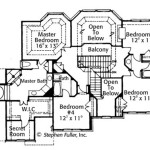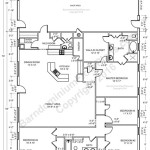Floor Plans for Single-Family Homes
Designing a single-family home requires careful planning and consideration. A well-thought-out floor plan can enhance the functionality, comfort, and overall desirability of the property. In this article, we will explore various floor plan options and discuss the key factors to consider when creating a single-family home design.
Types of Floor Plans
The choice of floor plan depends on the specific needs and preferences of the homeowners. Some popular types include:
- Single-story plans: These are simple and efficient layouts with all rooms on one level. They are often ideal for smaller families or those who prefer easy access.
- Multi-story plans: These plans feature multiple levels, providing more space and separation. They can be suitable for larger families or those who want to create distinct living areas.
- Split-level plans: These designs combine elements of single-story and multi-story plans, with different levels split into separate sections of the house.
- Open floor plans: These plans emphasize seamless transitions between living spaces, with fewer walls and more open areas. They create a spacious and airy atmosphere.
Key Considerations for Floor Planning
When designing a floor plan, it is essential to consider several key factors:
- Lifestyle: The floor plan should reflect the homeowners' daily routines and activities. Consider the number of bedrooms and bathrooms, the size and arrangement of living spaces, and the need for dedicated work or hobby areas.
- Privacy: The plan should provide adequate privacy for different members of the household. Consider the placement of bedrooms, bathrooms, and other private areas to ensure a comfortable living environment.
- Flow: The floor plan should promote a smooth flow of traffic throughout the house. Avoid bottlenecks or awkward transitions between rooms.
- Natural light: Position windows and doors to maximize natural light in all rooms. This can create a bright and inviting atmosphere while reducing energy consumption.
- Storage: Ample storage space is crucial for a well-organized home. Plan for closets, built-ins, and other storage solutions throughout the house.
Sample Floor Plans
Here are some sample floor plans to illustrate different design options:
- Single-story ranch plan: A popular layout with three bedrooms, two bathrooms, a spacious living room, and a kitchen connected to a dining area.
- Two-story colonial plan: A traditional design with a formal living room and dining room on the first floor, and four bedrooms and two bathrooms on the second floor.
- Split-level plan: A versatile option with a raised living area, a lower level family room, and bedrooms on both levels.
- Open floor plan: A modern layout with a large open living, dining, and kitchen area that flows seamlessly into one another.
Conclusion
Floor plans are the foundation of single-family home design. By considering the specific needs of the homeowners and incorporating key design principles, architects and designers can create functional, comfortable, and visually appealing layouts. The right floor plan can enhance the livability and value of a single-family home for years to come.

Floor Plan Of A Typical Single Family Detached House Scientific Diagram
Figure A 2 Single Detached House Floor Plans 61 Scientific Diagram

Top 10 Duplex Plans That Look Like Single Family Homes Houseplans Blog Com

Today S New Single Family Homes Building Bigger For A Forever Residence

Single Family Home Design Cad Pro

Single Family Small House Plans Floor Photos

Duplex With Single Family Appearances 69382am Architectural Designs House Plans

2 Story House Plan New Residential Floor Plans Single Family Homes Blueprints

Floor Plans For The Single Family Two Y Housing Prototype Scientific Diagram

Affordable Single Family Detached Home Designs Pro Builder








